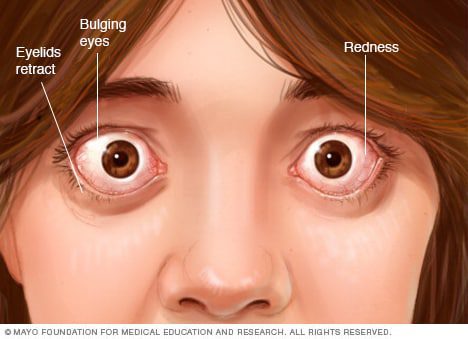Contents
What is Graves’ disease?
Graves’ disease is related to hyperthyroidism, which can have more or less significant impacts on the functioning of the body: cardiovascular, respiratory, muscular, and others.
Definition of Graves’ disease
Graves’ disease, also called exophthalmic goiter, is characterized by hyperthyroidism.
Hyperthyroidism is itself defined by too much production (more than what the body needs) of thyroid hormones, produced by the thyroid. The latter is an endocrine gland, producing hormones essential in the regulation of the various functions of the body. It is located at the anterior part of the neck, below the larynx.
The thyroid produces two main hormones: triiodothyronine (T3) and thyroxine (T4). The first being produced from the second. Triiodothyronine is also the hormone most involved in the development of many body tissues. These hormones circulate through the body through the blood system. They are then distributed to target tissues and cells.
Thyroid hormones are involved in metabolism (a set of biochemical reactions that allow the body to maintain a state of equilibrium). They also come into play in the development of the brain, allow the optimal functioning of the respiratory, cardiac or nervous system. These hormones also regulate body temperature, muscle tone, menstrual cycles, weight and even cholesterol levels. In this sense, hyperthyroidism then causes dysfunctions, more or less important, within the framework of these various functions of the organism.
These thyroid hormones are themselves regulated by another hormone: the thyreotropic hormone (TSH). The latter is produced by the pituitary gland (endocrine gland present in the brain). When the thyroid hormone level is too low in the blood, the pituitary gland releases more TSH. Conversely, in the context of an excessively high thyroid hormone level, the endocrine gland of the brain responds to this phenomenon, by a decrease in the release of TSH.
In the context of pregnancy, thehyperthyroidism can lead to more serious consequences for both mother and child. It can lead to spontaneous abortion, premature delivery, malformations in the fetus or even functional disorders in the child. In this sense, close monitoring for these sick pregnant women must be carried out.
Causes of Graves’ disease
Graves’ disease is an autoimmune hyperthyroidism. Or a pathology caused by a deficiency of the immune system. This is mainly due to a circulation of antibodies (molecules of the immune system) capable of stimulating the thyroid. These antibodies are called: anti-TSH receptors, otherwise called: TRAK.
The diagnosis of this pathology is then confirmed when the TRAK antibody test is positive.
The therapeutic treatment of this disease depends directly on the level of TRAK antibodies measured in the blood.
Other antibodies can also be the subject of the development of Graves’ disease. These concern between 30% and 50% of patient cases.
Who is affected by Graves’ disease?
Graves’ disease can affect any individual. In addition, young women between 20 and 30 are more concerned by the disease.
Symptoms of Graves’ disease
Hyperthyroidism, directly related to Graves’ disease, can cause certain signs and symptoms. Notably :
- thermophobia, either hot, sweaty hands, or excessive sweating
- diarrhea
- visible weight loss, and for no underlying reason
- a feeling of nervousness
- increased heart rate tachycardia
- respiratory failure, dyspnea
- of the’hypertension
- muscle weakness
- chronic fatigue
The diagnosis is then effective with regard to these symptoms felt by the patient. These data can then be supplemented by performing an ultrasound of the goiter, or even by performing a scintigraphy.
In the setting of Basedowian exophthalmos, other clinical signs are identifiable: burning eyes, swelling of the eyelids, weeping eyes, increased sensitivity to light (photophobia), eye pain, and others. The scanner can then confirm or deny the primary visual diagnosis.
Treatments for Graves’ disease
The primary diagnosis is then clinical and visual. The next phase is the performance of additional medical examinations (scanner, ultrasound, etc.) as well as biological examinations. These result in the analysis of the level of TSH in the blood, as well as thyroid hormones T3 and T4. These biological analyzes make it possible, in particular, to assess the severity of the disease.
Initially, the treatment is medicamentous. It results in the prescription of Neomercazole (NMZ), over an average period of 18 months. This treatment is variable depending on the level of T3 and T4 in the blood and must be monitored, once a week. This medication can cause side effects, such as fever or the development of sore throat.
The second phase, in the most extreme cases, the treatment is then surgical. This surgical procedure consists of a thyroidectomy.
As for Basedowian exophthalmos, this is treated with corticosteroids in the context of acute eye inflammation.










